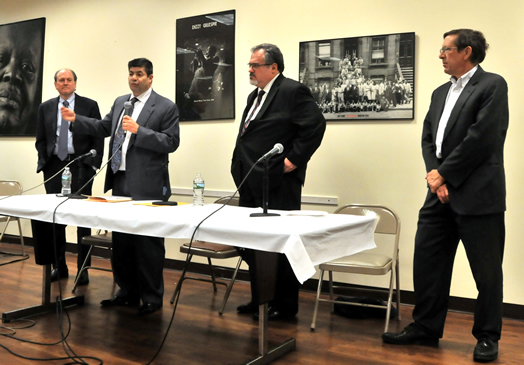Allegro
Showdown
When union rights come under fire, it’s time for labor activists to stand up
Volume 117, No. 1January, 2017

LEGAL CORNER
Harvey Mars, Esq.
Harvey Mars is counsel to Local 802. Legal questions from members are welcome. E-mail them to HsmLaborLaw@HarveyMarsAttorney.com. Harvey Mars’s previous articles in this series are archived at www.HarveyMarsAttorney.com. (Click on “Publications & Articles” from the top menu.) Nothing here or in previous articles should be construed as formal legal advice given in the context of an attorney-client relationship.
After the Revolutionary War, our country’s transformation to a democratic republic did not go as smoothly as one would imagine. Many soldiers did not receive the pay they had been promised. Huge taxes were levied on citizens to pay the considerable war debt. Many citizens who were unable to pay the tax had their property seized and were sentenced to serve time in debtor’s prison. Angry veterans in Massachusetts led by Daniel Shays revolted in protest and shut down local courts. The uprising, known as Shays’ Rebellion, was quickly quashed. Several protestors were killed.
This incident was a relatively minor one in our nation’s history. However, the debate that the revolt stirred among the Founding Fathers carries a message that has particular relevance today, as the labor movement faces unprecedented challenges with the inauguration of Donald Trump.
In a letter Thomas Jefferson sent to James Madison about Shays’ Rebellion, Jefferson wrote: “I hold that a little rebellion, now and then, is a good thing, and as necessary in the political world as storms in the physical…It is a medicine necessary for the sound health of government.” Later, in a letter he penned to Col. William Smith, Jefferson wrote again in reference to Shays’ Rebellion: “The tree of liberty must be refreshed from time to time with the blood of patriots and tyrants.” These quotes bubbled into my consciousness while I was addressing attendees during Local 802’s Dec. 2 membership meeting. While I do not (and will not) advocate actual physical rebellion, equally potent non-violent weapons are available, sanctioned by federal labor law. There are options we must all consider if the labor movement is to survive what may portend to be its bleakest hours in decades.

Local 802 counsel Harvey Mars spoke at the Dec. 2 meeting where union members and officers discussed labor movement strategy under President Trump. Photo: Walter Karling
During the meeting, counsel Susan Davis outlined potential challenges to organized labor under President Trump. But first, it would be fair to say that the last eight years have witnessed some of the most significant and progressive legal advances in labor relations in recent history. The National Labor Relations Board under the Obama administration has issued some of the most beneficial pro-worker rulings and regulations since the original enactment of the National Labor Relations Act. Some of these advances I have outlined in articles published in these pages.
For instance, in my November 2015 column, I reported on several of the NLRB’s rulings that expanded the boundaries of labor’s organizational rights. For instance, the NLRB has revamped the union election rules to streamline the petition process and permit elections to be held in a substantially shorter time frame. It has expanded the joint-employer concept so that a more pragmatic standard is used. It has expanded the NLRA’s definition of employee to cover teaching assistants and graduate students. It has extended protection to internet and e-mail communications. These progressive rulings were formulated to expand the universe for labor organizing efforts.
It is clear, as noted by Ms. Davis, that these rulings are now in grave jeopardy, since the Trump NLRB will be influenced by Trump’s political proclivities, which as we can see from his resistance to union organizing efforts in his hotels in Las Vegas, is decidedly anti-labor. The dynamic rulings issued by an NLRB committed to expand the outer reaches of the NLRA will most likely be overruled. The current dissenting voice at the NLRB will now speak for the majority.
Furthermore, the composition of the judiciary will change, especially at the Supreme Court. With three judges over the age of 75, there may be additional openings on the court that will impact rulings for the next decade or longer. It is a sure bet that the Supreme Court will revisit the issue of whether it is constitutionally permissible for public sector unions to require core members to pay agency fees. This time, I think unions will not be as lucky.
However, as bleak as the picture may appear, we must take heed that the pendulum has shifted before against the labor movement. During the Reagan and Bush administrations, extremely restrictive rulings were issued by the labor board that severely constrained union rights. Ronald Reagan single handedly destroyed PATCO – the air traffic controllers’ union – an event that the labor movement is still attempting to recover from today. Likewise, we have survived many horrific Supreme Court rulings. Recall that the Supreme Court had originally declared the NLRA unconstitutional!
Proponents and advocates of organized labor must realize that all is not lost. The end is not here. The heart of the NLRA remains intact. Section 7 shelters employees’ rights to organize and engage in concerted activity for their mutual aid and protection. Thus, despite the assault that the labor movement will now likely sustain, its basic and primary right to organize and negotiate will persist during the tempest. The NLRA has the mechanism by which we can engage in our own “labor’s rebellion.”
I am happy to say that the graduate students at Columbia University – who were the catalyst behind the recent NLRB ruling giving paid student assistants the right to organize – have picked up this gauntlet by voting in favor of unionization by a vote of 1,602 to 623. This makes Columbia University the first private university to have a union of graduate students certified since the NLRB decision was rendered. The UAW will be negotiating on their behalf.
Like these students, we must take advantage of our union rights now more than ever. For the moment, we can no longer rely on the government to codify protections that workers need. This sentiment was recently echoed by the AFL-CIO’s published response to the Trump presidency. There, the AFL-CIO noted that union organizing and collective bargaining are actually methods of social change. We need to try our hardest. We cannot afford anything less as our very survival is at stake.
